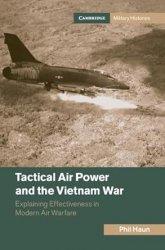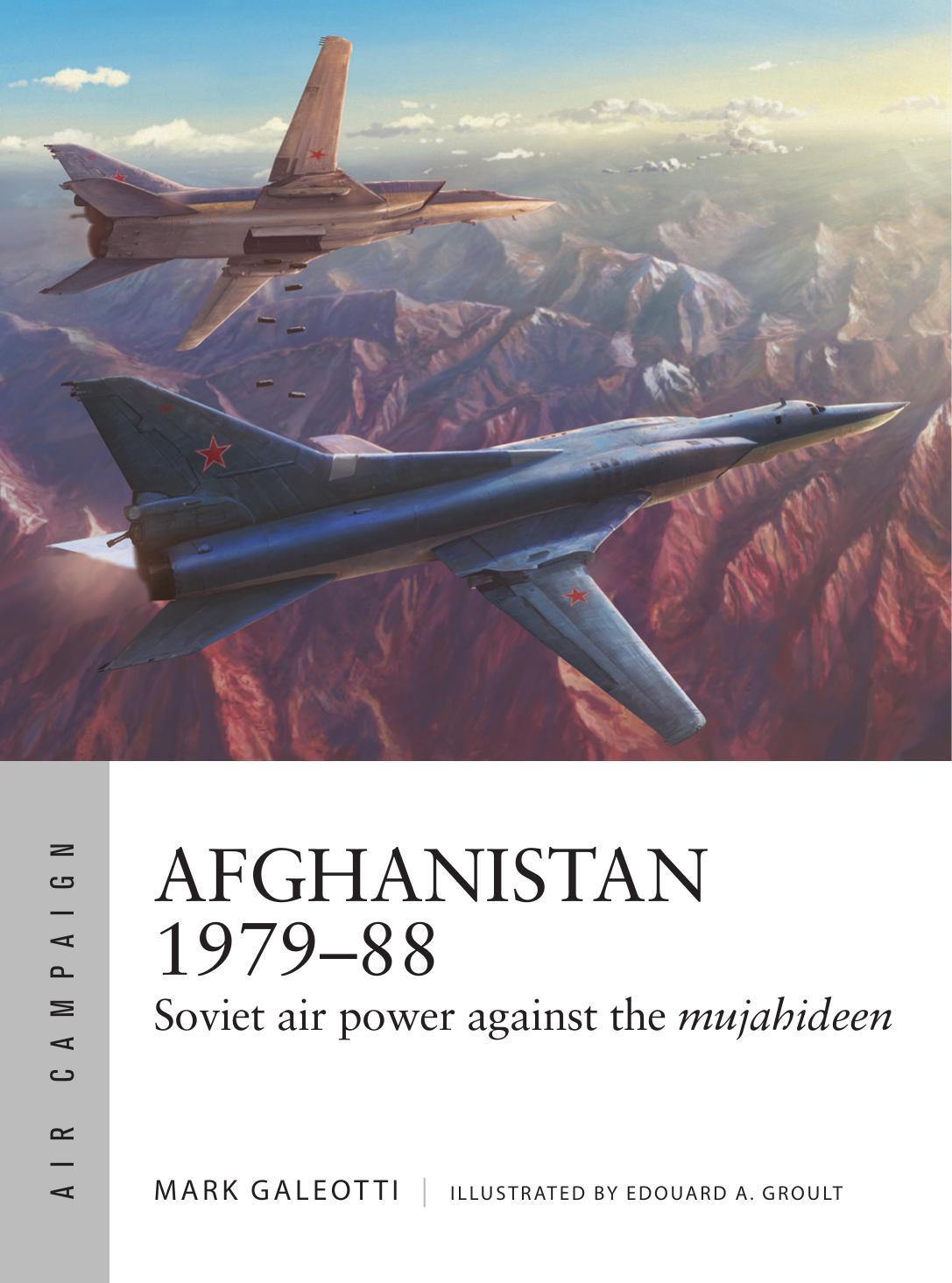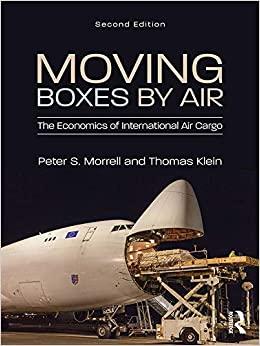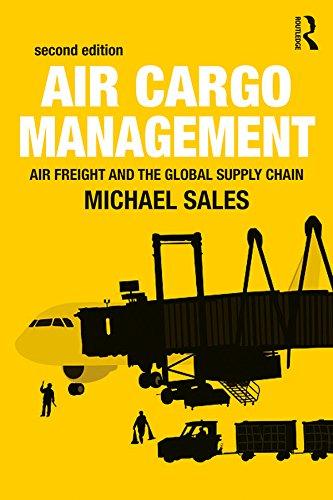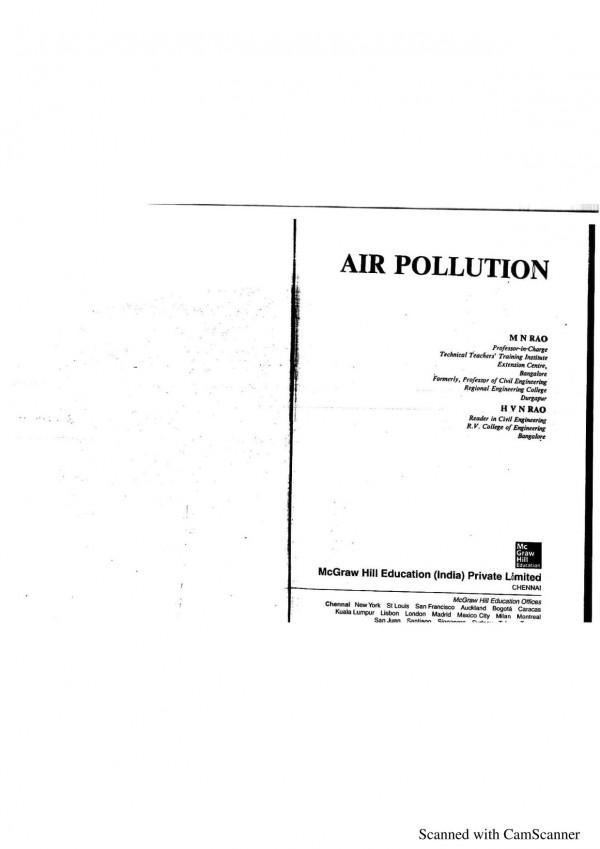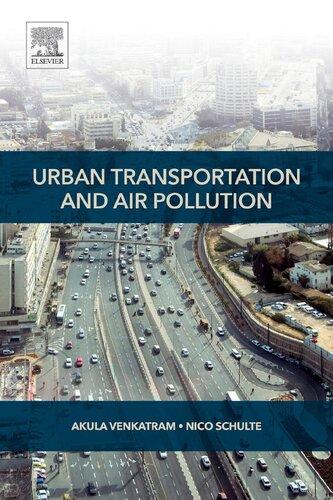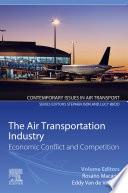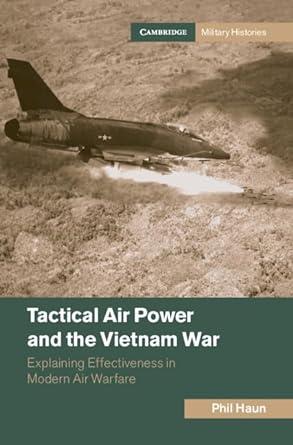TothememoryofStephenChiabotti
1.1ModernUSaircampaigns page 8
4.1USAFairoperationsinSouthVietnam:1965–1967 90
7.1USAFmajorstrikeactivityinLinebackerI 190
8.1Operationalfactorsaffectingairoperations 208
8.2Environmentalfactorsaffectingairoperations 214
8.3Codingoperational–environmentalfactorsand military–politicaloutcomesformodernUSaircampaigns 219
Preface
Theoriginsofthisbookdatebacktothespringof1999.While flyingan A-10overKosovo,Iwasfrustratedattemptingtolocate,identify,and attackSerbian fieldedforces.1 Later,IstudiedairpowertheoryattheUS AirForceSchoolofAdvancedAirandSpacePowerStudies(SAASS)at MaxwellAirForceBase,Alabama.WhileIreadmuchonstrategic bombing,therewaslittleondirectlyattacking fieldedforces,withtwo exceptions.In AirPowerandArmies,J.C.Slessorarguedagainstcloseair support(CAS)apartfrominexceptionalcases,preferringanindirect approachagainstanarmybybombingproductionfacilitiesandinterdictingwarsuppliesfromarrivingonthebattlefield.2 In BombingtoWin, RobertPapeadvocatedairpoweragainstenemyarmies,especiallythe interdictionofconventionalmechanizedforces’ supplylines.Papedid not,however,provideatheoryfortacticalairpower.Heacknowledged that “coerciveairstrategiesbasedondenyingtheenemyvictoryonthe battle fielddevelopedwithoutthebene fitofanairtheoristtoorganizethe ideasintoacoherentsetofprinciples,thoughJohnC.Slessor,aBritish airmanwhowroteinthe1930s,cametheclosest.”3
AfterSAASS,IdeployedtoAfghanistanand flewincounterinsurgencyandcounterterrorismoperations.Afterward,Icompletedgraduate workatMassachusettsInstituteofTechnology(MIT)andbeganteachingmilitarystrategyattheUSNavalWarCollegeandlateratYale University,whereIlecturedonairpowerintheVietnamWar. Throughresearch,discussionwithcolleagues,andreflection, Idevelopedthetacticalairpower(TAP)theorypresentedinthisbook. CriticsmayclaimthatasanA-10pilot,Iwouldnaturallyarguethatthe mostcrucialutilizationofairpowerisdirectlyattackingenemy fielded
1 ChristopherHaaveandPhilHaun,eds., A-10soverKosovo (MaxwellAFB:AirUniversity Press,2003).
2 J.C.Slessor, AirPowerandArmies (Oxford:OxfordUniversityPress,1936).
3 RobertPape, BombingtoWin:AirPowerandCoercioninWar (Ithaca,NY:Cornell UniversityPress,1995),69.
forces.Anauthoriscaptivetotimeandexperience.Idonotdenyadeep emotionalattachmenttothecombataircraftI flew,whichstillclaimsa holdonmypersonalandprofessionalidentity.However,anadvantageof beinganexpertpractitioneristhatitallowsforadeeperunderstanding oftheprofession’schallenges.From first-handexperienceofover 200combatmissions flownoverIraq,Bosnia,Kosovo,andAfghanistan, Ihavelearnedwhattacticalairpowercanandcannotaccomplish.Ihave alsonotedhowtheenemyreactstothecrediblethreatofairstrikes. Idevelopedthetheorypresentedin Chapter2 andobservedtheoperationalandenvironmentalfactorsconsideredin Chapter8 fromyearsof combatandstudy.Finally,tothedisappointmentofmyA-10squadron mates,thisbookdoesnotadvocatefortheA-10orCAS.Thisposition maybeasurprise,sinceCAShasprovenessentialincounterinsurgency operationsinAfghanistanandIraqfortwodecades.Dispersedoccupation forcesdidnothavetheorganic firepowertosuppressinsurgentattacks. Friendlygroundforcesdependedonairpowertorespondquickly. However,inmodernconventionalwarfare,airpowerhasbestbeen employedbeyondthefrontlines.InsteadofCAS,tacticalaircraft(tacair) havebeenmosteffectiveinarmedrecce(reconnaissance).Armedrecce, directattacksagainstenemy fieldedforces flownbeyondtherangeof CAS,hasbeenknownbymanynamesandacronymsovertimeandin differentwars,includingAFAC,FACA,DAS,Kill-BoxCAS,SCAR, KillerScout,BAI,andbattlefieldinterdiction.Airpowerhashadits greatestimpactthrougharmedrecce,bydeterringenemyarmiesfrom concentratingandmaneuvering.
Iamgratefultothemanywhohavecontributedtothisbook.From MIT’sSecurityStudiesProgram(SSP),Iamforeverindebtedtothe communityofdedicatedscholarsledbysuchbrilliantmindsasBarry PosenandTaylorFravel.Theyhaveprovidedmewithanintellectual home.IamfurtherindebtedtoOwenCoteforthecountlessdinners wherewediscussedtopicsrelatedtothisbook.OtherSSPalumniwho haveprovidedinputsincludeCaitlinTalmadge,JoshRovner,andJosh Shifrinson.SpecialthanksgoouttotwofellowSSPalumniBrendan GreenandJonLindsay,whoprovidedinvaluableinputstoanearlydraft, alongwithHeatherVenable,TomKitsch,andMikePoznansky.My coauthor,colleague,andfriendColinJacksonhasfurtheraidedand encouragedme.4 OurtriptoVietnam,whichincludedvisitstoAnLoc, Hue,KheSanh,thedemilitarizedzone(DMZ),Hanoi,andDienBien
4 Thecoauthoredarticleprovidesthebasisfor Chapter7.PhilHaunandColinJackson, “BreakerofArmies:AirPowerintheEasterOffensiveandtheMythsofLinebackerIand IIintheVietnamWar” InternationalSecurity 40:3(Winter2015/16):139–178.
Phu,wascrucialtomybetterappreciationofgeography,terrain,and weatherintheregion.Inaddition,attheUSNavalWarCollegeIhave beenencouragedbyTimSchultz,MikeO’Hara,MilanVego,Andy Stigler,SallyPaine,andNickSarantakes.Ialsoappreciatedinputfrom Adrian “Yo” Schuettke,whocotaughtwithmeacourseonModernAir PowerTheory.IhavebeenmentoredandbefriendedbyTomHughes andRichMuellerfromSAASS.OnanInternationalStudiesAssociation panel,MonicaDuffyToftprovidedatimelyandmuch-neededassessmentofanearlydraftofthetheorychapter.ToBonnie,mylong-time editor-in-chief,thanksforthededication,honestfeedback,andconstant reminderstomakemyprosemorereadabletoabroaderaudience.
Finally,Iwanttoacknowledgethecontributionsofadepartedmentor, colleague,andfriend,StephenChiabotti.Heencouragedmetotakeon thisambitiousprojectandcontributedtoitsearlytheoreticaldevelopment.
Theviewsexpressedbytheauthordonotreflectthoseofthe DepartmentofDefenseoritsservices.
Abbreviations
A2/ADanti-access/areadenial
AAAanti-aircraftartillery
AAGSArmyAirGroundSystem
ABCCCAirborneCommandandControlCenter
ACTSAirCorpsTacticalSchool
AFACairborneforwardaircontroller
AGOSair-groundoperationsystem
AIMAirInterceptMissile
ALOAirLiaisonOfficer
ANGLICOAirNavalGun fireLiaisonCompany
ArmedReccearmedreconnaissance
ARVNArmyoftheRepublicofVietnam(SouthVietnam)
ASOCAirSupportOperationCenter
ATOairtaskingorder
AWACSairbornewarningandcontrolsystem
BAIbattlefieldairinterdiction
BDAbattledamageassessment
BVRbeyondvisualrange
C2commandandcontrol
CAPcombatairpatrol
CAScloseairsupport
CBUclusterbombunit
CIACentralIntelligenceAgency
CINCPACCommander-in-ChiefofUSPaci ficCommand
COLOSSYSCoordinatedLORANSensorStrikeSystem
COSVNCentralOf ficeofSouthVietnam(VietCong)
DAFDesertAirForce
DARPADefenseAdvancedResearchProjectsAgency
DASdirectordeepairsupport
DASCdirectairsupportcenter
DIADefenseIntelligenceAgency
DMZdemilitarizedzone
xiv
ECMelectroniccountermeasures
FACforwardaircontroller
FACAforwardaircontrollerairborne
FASLforwardairsupportlinks
FLIRforward-lookinginfrared
FLOTforwardlineofowntroops
FOFAfollow-onforcesattack
FSCC firesupportcoordinationcenter
FSCL firesupportcoordinationline
GBADground-basedairdefense
GCIground-controlledinterception
GLOgroundliaisonofficer
GPSglobalpositioningsystem
HADPBhigh-altitudedaylightprecisionbombing
HUMINThumanintelligence
IADSintegratedairdefensesystem
IAFIsraeliAirForce
ICBMintercontinentalballisticmissiles
ICCIntelligenceControlCenter
IEDimprovisedexplosivedevice
IFFidenti ficationfriendorfoe
IRSTinfraredsearchandtrack
ISCInfiltrationSurveillanceCenter
ISRintelligence,surveillance,andreconnaissance
JCSJointChiefsofStaff
JSTARSJointSurveillanceTargetAttackRadarSystem
JTACjointtacticalaircontroller
KLAKosovoLiberationArmy
KTOKuwaitiTheaterofOperation
LGBlaser-guidedbomb
LOClinesofcommunication
LOOlinesofoperation
LORANlong-rangenavigation
LRASMlong-rangeanti-shipmissile
LVClive,virtual,andconstructive
MACVMilitaryAssistanceCommandVietnam manpadsman-portableairdefensesystem
MTImovingtargetindicator
NATONorthAtlanticTreatyOrganization
NTCNationalTransitionCouncil(Libya)
NVANorthVietnameseArmy
NVGnightvisiongoggles
xviListofAbbreviations
OAFOperationAlliedForce
OMGOperationalManeuverGroup
PACAFPaci ficAirForces
POLpetroleumoillubricants
POWprisonerofwar
RAFRoyalAirForce(GreatBritain) reccereconnaissance
ROErulesofengagement
RPRoutePackageorRoutePack
RPAremotelypilotedaircraft
RVNAFRepublicofVietnamAirForce(SouthVietnam)
RVNMFRepublicofVietnamMilitaryForces(SouthVietnam)
RWRradarwarningreceivers
SAASSSchoolofAdvancedAirandSpacePowerStudies
SAMsurface-to-airmissile
SCARstrikecoordinationandreconnaissance tacairtacticalaircraft
SEADsuppressionofenemyairdefenses
SLARside-lookingair-to-groundradar
SLOCsealinesofcommunication tacreccetacticalreconnaissance
TACCTacticalAirControlCenter
TACPtacticalaircontrolparty
TACStacticalaircontrolsystem
TAPtacticalairpower
TICtroopsincontact
TOWtube-launched,opticallytracked,wireless-guided TTPtactics,techniques,andprocedures
UAG UdarnyyeAviatsionnyyeGrouppy (AirStrikeGroups)
UKAFUkrainianAirForce
USAAFUnitedStatesArmyAirForces
USAFUSAirForce
USMCUSMarineCorps
USNUSNavy
VPAFVietnamPeople’sAirForce(NorthVietnam)
VCVietCong
VCIVietConginfrastructure
VKS Vozdushno-kosmicheskiyesily (Russian AerospaceForce)
VRvisualreconnaissance
VVS Voyenno-VozdushnyyeSily (SovietAirForce)
WMDweaponsofmassdestruction
1Introduction
InJune2002,theUnitedStatescommencedanaircampaigntorollback Iraqiairdefenses.USairforcesrespondedwhenradarsilluminatedtheir fightersbyadjustingtherulesofengagementforself-defense,attacking notonlythosespecificsitesbuttheentireIraqiairdefensesystem.1 By thetimeofthegroundinvasioninMarch2003,theUnitedStateshad longachievedairsuperiority.Inanticipationoffacinganair-onlycampaign,theIraqiArmydispersedratherthanconcentrateditsforcesat strategicchokepoints.Asaresult,thegroundforcesoftheUS-led coalitionmetlittleresistanceinwhatquicklyturnedintoaraceto Baghdad.Bydeterringtheenemyarmyfrommassingandmaneuvering, airpowerhadmadeitsmostsignificantcontributiontothewarbeforethe firstpairofAmericanbootstouchedIraqisoil.2 Theinvasionwouldhave takenonadifferentcharacterwithoutairpoweroverhead.Allowedto fightfromprepareddefenses,theIraqiscouldhaveslowedtheinvasion andinflictedmorecasualties,similartohownineteenyearslaterthe UkrainiansstalledtheRussianadvanceonKyiv. 3
TheinvasionofIraqdemonstrateshowairpowerworkswhendirectly attacking fieldedforces.Underalethalairthreat,enemyarmiesdisperse andhide,whichprovidesfriendlygroundforcesasigni ficantadvantage. Coordinatedairandgroundattacksplaceanarmyonthehornsofa dilemma.Doesitconcentrateandmaneuver,astheNorthVietnamese Army(NVA)didatKheSanhandagainintheEasterOffensive,onlyto bedecimatedbyairstrikes?Ordoesitdisperseandhide,astheIraqi Armydid,andbeoverrun?
Threatenedarmiesusuallychoosethelattercourse,withairpower deterringthemfrommassingandmaneuvering.Whenmosteffective,air
1 ThroughoutthisbookUSairforcesrefertotheAirForce,Navy,andMarine fixedwingaviation.
2 BenjaminLambeth, TheUnseenWar:AlliedAirPowerandtheTakedownofSaddamHussein (Annapolis,MD:NavalInstitutePress,2013),66–71.
3 TheargumentisnotthattheIraqiswouldhavestoppedtheinvasion,astheUkrainians did,butthatitcouldhaveimposedmorecosts.
forcesdonotdestroyarmies,withKheSanhandtheEasterOffensive beingexceptions,butinsteaddenytheenemyarmyitspreferredstrategy ofconcentratingatthedecisivepoint.4 Justasthebettermeasureofa policeforceisnotthetotalarrestsmadebutthenumberofcrimes committed,anairforceshouldbeevaluatednotbythenumberoftargets destroyedbutbyhowairpoweraffectstheenemy ’sdecision-making.5 CarlVonClausewitz,in OnWar,understoodthesigni ficanceofenemy actionsnottakenwhenhearguedthatonemustaccountfortheconsequencesoftheengagementsnotwaged.6
Thisbookintroducesatheoryoftacticalairpower(TAP)toexplain why,how,andwhenmodernairpowerworks.AfterWorldWarII,two technologieschangedthecharacterofairwarfare.First,intheColdWar theproliferationofthermonuclearweaponsandtheexorbitantcosts anticipatedfromnuclearwardeterredtheUnitedStatesandtheSoviet Union.Giventheriskofescalation,theUnitedStatesfoughtwarsnot againstothernuclear-armednationsbutagainstweakerstateandnonstateactors.Nuclearrivalshavecompetedthroughtheiralliesandproxiesbysupplyingweapons,training,anddiplomaticsupport,asin Vietnam,Afghanistan,andUkraine.Theasymmetricnatureofthese warshas,inturn,shapedhowUSairpowerhasbeenemployed.
Thesecondtechnologycharacterizingmodernairwarfarehasbeenthe proliferationofradar-andinfra-guidedair-to-airandsurface-to-airmissiles.Sincetheearly1960s,thelethalityofthesesystemshassigni ficantly increasedtherisksofcombatincontestedairspace.Tosurvivesuch hostileconditions,USairforcestransitionedfrombomberstotactical aircraft(tacair)astheirprimarycombatplatform.B-52scontinuedto providestrategicdeterrenceaspartoftheUSnucleartriad,andlater, stealthbombersarmedwithprecision-guidedweaponsconductedstrategicbombing.Inaddition,conventionallyarmedbombershavealso flowninlower-threatareas,suchasoverSouthVietnam.However, overalltacairhasbeentheworkhorseofmodernaircombat,utilizedfor airsuperiority,strategicbombing,airinterdiction,anddirectattack.
ThisbookexaminesmodernUSairwarfare,con flictswherenonnuclearnations,protectedbyintegratedairdefensesystems(IADS),have,
4 CarlVonClausewitz, OnWar (Princeton,NJ:PrincetonUniversityPress,1976),195; ThisalsofollowsSunTzu’sadviceofattackingtheenemy’sstrategy.SunTzu TheArtof War (Oxford:OxfordUniversityPress,1983),77.
5 Thereareotherreasonswhycrimeratesmaybelowthathavelittletodowiththe effectivenessofthepoliceforce.Theproblemofshowingcausationwhentheonlyproof isthelackofevidenceisliketheproblemofassessingtheeffectivenessofdeterrence.How doesoneknowthatitwasthethreatofairstrikesthatdeterredenemyaction?
6 Clausewitz, OnWar,181.
tovaryingdegrees,contestedairsuperiority.7 Omittedfromexamination arecon flictswithstateswithoutviableairdefenses,includingGrenada, Panama,andAfghanistan.Alsoexcludedarecounterinsurgencyand counterterrorismoperations.Overthepasttwodecades,USairforces havetargetednon-stateactorsintheMiddleEast,CentralAsia,and Africa.Inthesecases,whereairsupremacyhasbeenassumed,thetype ofaircraftandtacticsutilizedhavedifferedmarkedlyfromthemodernair warsconsideredinthisbook.Howbesttoemployairpowertocounter insurgenciesandterroristsremainsanimportanttopic,butnotoneexaminedindetailhere.8
StrategicBombing,AirInterdiction,andDirectAttack
TheUnitedStateshasfoughtnumerousmodernairwarsoverthepast sixdecades,facingNorthVietnamese,Iraqi,BosnianSerb,Serbian,and Libyanairdefenses.Inseveralofthesecon flicts,theUnitedStates conductedmultipleaircampaigns.9 Forinstance,theUnitedStates initiatedtheRollingThunderaircampaignoverNorthVietnamwhile simultaneously fightingajoint,combinedarmscampaigninSouth Vietnam.
Thetypeofaircampaigncanbecategorizedbyitstheoryofvictoryfor howairpowerachievesmilitaryandpoliticalobjectives.Therearethree generaltypesofaircampaigns:strategicbombing,airinterdiction,and directattack.Strategicbombingaimstoobtainpoliticalgoalsbycoercing theenemynationtomakeconcessions.Airforcesconductstrategic bombingindependentofsurfaceforces,overflyingthebattle fieldto targettheenemy ’spopulation,economy,orleadership.
Airinterdiction,bycontrast,indirectlytargetstheenemymilitaryby cuttingoffitssupplylinesandreinforcements.Airinterdictioncan weakentheenemyaspartofadenialstrategytocoercetheenemyto makeconcessions,astheUnitedStatesfailedtodoinRollingThunder. Also,airinterdictioncancontributetoabrute-forcegroundinvasion,as
7 PriortoDesertStormIraqprocureditsKARI(IraqspelledbackwardsinFrench)air defensesystemfromFrance.
8 SeeJamesCorumandWrayJohnson, AirPowerinSmallWars:FightingInsurgentsand Terrorists (Lawrence:UniversityPressofKansas,2003);AnthonySchinella, Bombs withoutBoots:TheLimitsofAirpower (Washington,DC:Brookings,2019);PhilHaun, ColinJackson,andTimSchultz,eds., AirPowerintheAgeofPrimacy:AirWarfaresincethe ColdWar (Cambridge:CambridgeUniversityPress,2021).
9 Acampaignisdefinedasaseriesofrelatedoperationsconstrainedbytimeandspaceto achievemilitaryorstrategicobjectives.DepartmentofDefense, DictionaryofMilitaryand AssociatedTerms (November2021),29, www.supremecourt.gov/opinions/URLs_Cited/ OT2021/21A477/21A477-1.pdf.
attemptedinDesertStormin1991.Airstrikesmayoccurdeepinenemy territory,targetingthesourceoftheenemy’smilitarycapabilities.During LinebackerI,theUnitedStatesbombedNorthVietnameserailwaysand harborstopreventimportsfromChinaandtheSovietUnion.Theseair interdictionmissionsstrucklarge, fixedstructuressuchasbridges,railwaystations,andportfacilities.Alternatively,airinterdictionmayattack mobiletransports,suchasthetruckstraversingtheHoChiMinhTrail throughsouthernLaos.
Directattackisthethirdtypeofaircampaign,usuallyaspartofa combinedarmsoperation,asoccurredinSouthVietnam.The1999USledNATO(NorthAtlanticTreatyOrganization)airwaragainstthe SerbianArmyinKosovowasanexception.Serbiansoldiersinitially respondedtodirectairattacksbydispersingandhiding.However, withoutthecrediblethreatofanopposinggroundforce,theSerbssoon swappedtheirmilitaryvehiclesforcivilianautomobiles.Theycontinued theirethniccleansingwhileNATOtacaircircledhelplesslyoverhead.10 Asthisbookwilldemonstrate,directairattackmissionsaremoreoften andmoreeffectivelycoordinatedwithfriendlyarmies.
Thosefamiliarwithcombinedarmsdoctrinefordirectattackwill first thinkofcloseairsupport(CAS),missionsconductednearfriendly armies.Toavoidfratricide,CASrequiresdetailedcoordinationand integrationwiththegroundschemeofmaneuver.Jointtacticalaircontrollers(JTACs),embeddedingroundunits,identifytargetsandcontrol airstrikes.CAShasbeenreferredtoas “flyingartillery” sinceitprovides thesameessentialfunctionasartillerysupportinggroundunits. DedicatedCASaircraft,suchastheA-1SkyraideroverVietnamand theA-10WarthogoverIraqandAfghanistan,havelongbeenhailedby soldiers.Theyareappreciated,inpart,becausethetroopscanobserve theaircraftworkingoverhead.EmergencyCASisparticularlyvaluedfor troopsincontact(TIC)situationswhereairstrikesmaybecriticaltothe soldiers’ survival,asoccurredthroughouttheBattleofKheSanhand repeatedlyduringtheEasterOffensive.EspeciallyprizedisCASin counterinsurgencies,wheredispersedfriendlytroopsrelyonthequick responseofairpower.Whilepopularwithsoldiers,CASislimitedinits effectivenessbyJTACandtargetavailability.Also,eachmissiontakes significanttimetobriefinboundaircraftonthetarget,threats,and restrictions.CASisalsoinefficientsinceusuallyfewermissionscanbe executedthanthesortiesavailable.Also,bydefinition,CASonlyoccurs
10 Theauthor flewasanA-10AirborneForwardAirController(AFAC)inKosovo.See ChristopherHaaveandPhilHaun,eds., A-10soverKosovo (MaxwellAFB,AL:Air UniversityPress,2003).
whenfriendliesareneartheenemy.Asaresult,thetacairallocatedfor CASisoftendivertedtostrikebehindthefrontlines.
Tacairhasmoreoftendirectlyattacked fieldedforcesbeyondtherange ofCAS.Variousnameshavebeenusedtodescribethesedeeperstrike missionsindifferentwars,includingarmedrecce(reconnaissance),BAI (battle fieldairinterdiction),KillBoxCAS,Killer-Scout,push-CAS, FACA(forwardaircontrollerairborne),AFAC(airborneforwardair controller),andSCAR(strikecoordinationandreconnaissance). BeforetheVietnamWar,theUSAirForcereferredtothismissionas battle fieldinterdictionbutremovedthetermfromitsdoctrineduringthe war. 11 Afterward,itreintroducedtherole,renamedbattlefieldair interdiction,tosupporttheUSArmy’sAirLandBattledoctrine.Air ForcecommandersthenrefusedtocallarmedreccesortiesBAIduring DesertStormandafterthewaragainstruckBAIfromitsdoctrine. Armedrecceisachallengingmissionthatrequiressharingtargeting prioritizationwithArmycommanders.12 Bycontrast,USMarineCorps aviationhasretainedthearmedreccemission,which,alongwithair interdiction,itreferstoasdeepairsupport(DAS).13 Thisbookuses thetermarmedreccetorefertothesedirectattackmissions flownabove thebattlefieldbutbeyondtherangeofCAS.
Unlikeairinterdiction,armedreccerequirescoordinationwithground forcesforstrikesinsidethebombline,nowreferredtoasthe firesupport coordinationline(FSCL).IntheVietnamWar,thebomblinewasa decon flictionmeasuretoreducefratricideandindicatewhereairforces neededtocoordinatewiththegroundforces.Inmodernairwarfare, airstrikesagainstenemyarmieshavemoreoftenbeenconductedas armedrecce.Inpractice,therehavebeenfeweropportunitiestoconduct CAS.TacairassignedtoCASoftendonot findtheirassignedJTACs withavailabletargetsandaredivertedtoarmedreccetosearchfortargets ofopportunitybeyondthebattlefront.Theparadoxwithdirectattackis thatfromatheaterperspective,airpowerconductsoperationsjointlyto bethehammerforthearmy ’sanvil. 14 Atthetacticallevel,however, aircrewmoreoftenconductarmedreccemissionsindependently,
11 AirForceManual(AFMAN)1-7, TheaterAirForcesinCounterair,InterdictionandClose AirSupport1March1954 (Washington,DC:DepartmentoftheAirForce,1954); TerranceMcCaffrey, WhatHappenedtoBattlefieldAirInterdiction? (MaxwellAFB,AL: AirUniversityPress,2004),16.
12 PhilHaun, “PeacetimeMilitaryInnovationthroughInterServiceCooperation” Journal ofStrategicStudies 43:5(2020),10.
13 USMarineCorps, AviationOperations MCWP3–20(Washington,DC:MarineCorps Headquarters,2018),2-1–2-2.
14 IcreditRobertPapeforthisanalogy.
beyondthecontrolofgroundforces.Airpower’sprimaryimpacton thesemissionsistocausetheenemytodisperseandhide.
DirectAttack
Inmodernwarfare,USairpowerismosteffectiveasdirectattack, employedaspartofajointcombinedarmscampaign.Formostofits history,however,airforceleadershavecontendedthatthetruevalueof airpowerissquanderedwhenusedinsuchamanner.Earlyairpower advocatesarguedthattheinventionoftheairplanechangedthenatureof warfare.Anairforcecouldbeasubstituteforarmiesandnavies.Interwar strategicbombingtheorists,includingGiulioDouhet,HughTrenchard, BillyMitchell,and,attheendoftheColdWar,JohnWarden,calledfor airforcestobeindependent,wieldingairpowerdecisivelybystrikingthe enemy ’spopulation,economy,orleadership.15 Eventhosewhoconcededthenecessityofdefeatingtheenemy’smilitarycontendedthatair powerisbestemployedindirectly,neutralizingthesourcesofenemywar productionorinterdictingitslinesofcommunication(LOC).16 Unfortunately,strategicbombingandairinterdictionrarelysucceed.17 Conventionalstrategicbombingcampaignsusuallydonotimposesufficientcoststocoerce.18 Whiletheoreticallyappealing,airinterdiction againstenemylandLOCusuallyfailsasenemyarmiesstockpilesupplies, repairroadsandbridges,anddevelopalternateroutes.Airpoweradvocatesdevelopedtheirtheoriesbasedonhowtheywishedairpowertobe
15 GiulioDouhet, CommandoftheAir1921 (Washington,DC:AirForceHistoryand MuseumsProgram,1998);HughTrenchard, “MemorandumfromRoyalAirForce ChiefofAirStaffHughTrenchardtoCHIEFSOFSTAFFSubcommitteeontheWar ObjectiveofanAirForce,2May1928” inPhilHaun,ed., LecturesoftheAirCorps TacticalSchoolandAmericanStrategicBombinginWorldWarII (Lexington:University PressofKentucky,2019),Appendix1;JohnWarden, “TheEnemyasaSystem” AirpowerJournal X:1(Spring1995),40–55;WilliamMitchell, WingedDefense:The DevelopmentandPossibilitiesofModernAirPowerEconomicandMilitary (NewYork: Putnam,1925).
16 J.C.Slessor, AirPowerandArmies (Oxford:OxfordUniversityPress,1936);Haun, LecturesoftheAirCorpsTacticalSchool.
17 RobertPape, BombingtoWin:AirPowerandCoercioninWar (Ithaca,NY:Cornell UniversityPress,1995);PhilHaun, Coercion,Survival&War:WhyWeakStatesResist theUnitedStates (PaloAlto,CA:StanfordUniversityPress,2015).
18 Kosovoistheexception,whereSerbianPresidentSlobodanMiloseviclikelyconceded becauseofthewar’simpactontheweakenedSerbianeconomy.Thereremainssome disputeastotheprimarycauseforMilosevic’sdecisiontoconcedeKosovo.For examplesseecontraryassessmentsbytwoRANDreportsbyStephenHosmer, The KosovoConflict:WhyMilosevicDecidedtoSettleWhenHeDid (SantaMonica,CA: RAND,2001),andBenjaminLambeth, NATO’sAirWarforKosovo:Strategicand OperationalAssessment (SantaMonica,CA:RAND,2001).
employed,oftentojustifyindependentservicestatus,ratherthanonhow airpowerhasprovenmosteffectiveincombat.Asanalternativeto existingairpowertheories,whichlookpromisingonpaperbutdisappointinpractice,thisbookpresentsatheoryforwhy,how,andwhen tacticalairpowerworksinmodernairwarfare.
Since1965,theUnitedStateshaswagedtwenty-threemodernair campaignsinVietnam,Iraq,Bosnia,Serbia,andLibya(Table1.1). EventhoughAirForceleaderspreferredstrategicbombingandair interdiction,theyreluctantlysupportedcombinedarmsoperationswhen orderedtodoso.Innearlyhalfofthecases(elevenoftwenty-three),US airforcesdirectlyattackedtheenemy’s fieldedforcesandachievedtheir militaryobjectivesmostofthetime(nineofeleven).Whenmilitarily successful,theyfurthercontributedtoobtainingUSpoliticalobjectives overhalfthetime(fiveofnine).Bycontrast,injustoveraquarterofthe cases(sixoftwenty-three),strategicbombingcampaignssucceededonly twice(twoofsix).TheUnitedStatesalsoattemptedairinterdictionsix times,withallbutonecampaignfailing.Insum,inmodernairwarfare, thoughUSairpowerhasnotalwaysbeeneffectiveinachievingmilitary andpoliticalobjectives,thedirectattackofmilitaryforceshasbeenthe strategymostoftenimplementedandthathasmostoftensucceeded.
From Table1.1,theVietnamWarstandsoutasthe firstmodernair war.Bytheearly1960s,therapidgrowthinthethermonucleararsenals oftheUnitedStatesandSovietUniondeterredanuclearwarbetween thesuperpowers.Theconcernoverescalation,byChineseorSoviet intervention,constrainedUSairstrikesanddissuadedtheUnited StatesfromagroundinvasionofNorthVietnam.Theintroductionof radar-guidedsurface-to-airmissiles(SAMs)increasedthelethalityofthe NorthVietnameseairdefensesystem.Heavybomberscouldnotfreely conductstrategicbombingcampaignsastheUnitedStateshaddonein WorldWarIIandtheKoreanWar.Vietnamisalsothelongestmodern airwar,spanningalmosteightyears.Itwasherethatmostmodernair warfaretookplace(thirteenoftwenty-threecases),includingmultiple strategicbombing,airinterdiction,anddirectattackcampaigns.Air superioritywasalsocontested,withtheUnitedStateslosingover9,000 fixedandrotary-wingaircraft.19 DuringtheVietnamWar,thecharacter ofmodernairpowerwasrevealedunderthecrucibleofcombat,where
19 Combat-andnon-combat-relatedlossesincluded3,744 fixed-wingand5,607 helicopters.ChrisHobson, VietnamAirLosses:AirForce,NavyandMarineCorps Fixed-WingAircraftLossesinSoutheastAsia1961–1973 (NorthBranch,MN:Specialty Press,2001);GaryRoush, “HelicopterLossesduringtheVietnamWar” Vietnam HelicopterPilotsAssociation(December2018), vhpa.org/heliloss.pdf.
Table1.1 ModernUSaircampaigns1
Year AircampaignOpponentStrategyMil/poloutcome
Mar–Jul1965RollingThunderNorthVietnamStrategic bombing Failure/failure
Mar65–Dec66RollingThunderNorthVietnamInterdictionFailure/failure
Jul65–Dec66CombinedArmsNorthVietnamDirectattackSuccess/failure
Jan67–Mar68RollingThunderNorthVietnamInterdictionFailure/failure
Jan67–Mar68KheSanh/TetNorthVietnamDirectattackSuccess/failure
Apr–Dec1967RollingThunderNorthVietnamStrategic bombing Failure/failure
Nov68–Jun70Commando HuntI-III NorthVietnamInterdictionSuccess/failure
Apr–Jun1970CambodiaNorthVietnamDirectattackSuccess/failure
Nov70–Mar72Commando HuntV-VII NorthVietnamInterdictionFailure/failure
Feb–Mar1971LamSon719NorthVietnamDirectattackFailure/failure
Mar–Sep1972EasterOffensiveNorthVietnamDirectattackSuccess/success
May–Oct1972LinebackerINorthVietnamInterdictionFailure/failure
Dec1972LinebackerIINorthVietnamStrategic bombing Success/success
Jan–Feb1991InstantThunderIraq Strategic bombing Failure/failure
Jan–Feb1991DesertStormIraq InterdictionFailure/failure
Jan–Feb1991DesertStormIraq DirectattackSuccess/success
Apr91–Oct98NoFlyZones, WMD Iraq DirectattackSuccess/failure
Aug1995Bosnia BosnianSerbsDirectattackSuccess/success
Mar–Jun1999Serbia Serbia Strategic bombing Success/success
Mar–Jun1999Kosovo Serbia DirectattackFailure/failure
Mar2003OperationIraqi Freedom Iraq Strategic bombing Failure/failure
Mar2003OperationIraqi Freedom Iraq DirectattackSuccess/success
Mar2011OdysseyDawnLibya DirectattackSuccess/success
TotalDirect attack 11/239/11Milsuccess 5/11Polsuccess
TotalStrat bombing 6/23 2/6Polsuccess
TotalAir interdiction 6/23 1/6Milsuccess 0/6Polsuccess
1 ThethirteencasesoftheVietnamWarareexaminedindetailin Chapters3–7 whilethe codingfortheremainingtencasesareexplainedin AppendixB.
aircrewrefinedtheoperationalconceptsformodernairwarfare,mostof whichremainvalidtoday.
BecauseoftheVietnamWar’scentralroleindevelopingmodernUS airpower,thebodyofthisbook(Chapters3–7)analyzesitsthirteenair campaigns.Vietnamcanbethoughtofasahistoricallaboratoryusedto testthetacticalairpowertheoryintroducedinthefollowingchapter.In theprocess,theeffectivenessofstrategicbombing,airinterdiction,and directattackaremeasured,andthevariousoperationalandenvironmentalfactorsthatplacelimitationsandconstraintsonairpowerare identi fied.However,chapter-lengthassessmentsofalltwenty-threeUS modernaircampaignsgobeyondthissinglevolume’sambitions. AppendixB summarizesthetenmodernaircampaignsthatfollowed Vietnam.Amoredetailedanalysisisavailablein AirPowerintheAgeof Primacy:AirWarfaresincetheColdWar. 20 Anevaluationofmodernair warfareintheVietnamWarprovidesabetterunderstandingofwhy,how, andwhentoemployairpowertodayandinthefuture.
OrganizationoftheBook
Thebookproceedsasfollows: Chapter2 providesahistoricalaccountof thedevelopmentoftacticalairpowerduringtheinterwarperiodand WorldWarIIinGermany,theSovietUnion,GreatBritain,andthe UnitedStates(readersunfamiliarwithairpowertheorymaywanttoread AppendixA first).Airandgroundforcecoordinationhaslargelybeen ignoredinpeacetime,andonlyincombathasasenseofurgencyarisen fordevelopingandrefiningjointdoctrine.Eventhen,thefocushasbeen ondefiningairandgroundcommandrelationshipsandimprovingthe coordinationbetweenanairforce’stacticalaircontrolsystems(TACS) andthearmy’sair-groundsystems(AAGS).Thesedoctrinalefforts increasedtheefficiencyofallocatingandcontrollingairpowertosupport groundoperations.However,largelyleftunspokenandunwrittenhas beenanunderstandingofwhy,how,andwhentacticalairpowerworks. TAPtheoryanswersthesequestionsbyassertingthatairpower’sasymmetricadvantageisitsabilitytolocateandattackmassedandmaneuveringarmies.Withairsuperioritysecured,lethalair-to-groundforces threatenarmies,causingthemtodisperseandhide.Theenemy ’sreaction,inturn,providesfriendlygroundforcesanadvantageinconducting bothoffensiveanddefensiveoperations.Unfortunately,atheory
explainingtheprimaryimpactofairpowerinmodernwarfarehasbeen absentuntilnow.21
ThebodyofthebookevaluatesTAPtheoryduringtheVietnamWar. Chapter3 examinesthe firsttwoyearsofmajorUScombatoperations from1965through1966.OverNorthVietnam,theRollingThunderair campaignfailedtoeitherisolatecommunistforcesinSouthVietnamor coerceNorthVietnamtowithdrawitssupportoftheinsurgency.Air powerprovedmoreeffectiveinthedirectattackoftheNorthVietnam ArmyandVietCong(NVA/VC)inSouthVietnam.TheUScombined armscampaignthwartedanoffensiveaimedatdividingSouthVietnam. Instead,well-executedalliedair-to-groundoperationscompelledthe enemytodisperseandhide.
Chapter4 evaluatesUStacticalairpowerfrom1967to1968.Over NorthVietnam,theRollingThunderairinterdictioncampaignstruggled toisolateNVA/VCforces.Simultaneously,astrategicbombingcampaigncouldnotcoerceHanoitowithdrawitssupportoftheinsurgency. ThedirectattackoftheNVA/VCforcesinSouthVietnamprovedmore effective,withtheultimatetestoccurringnearthedemilitarizedzone (DMZ)attheUSMarinebaseatKheSanh.Here,theNVAmassedtwo divisions,hopingtooverrunthemarinestoachieveadecisivevictory,as theNorthVietnamesehadagainsttheFrenchin1954atDienBienPhu. Instead,theAmericancombinedarmscampaigndefeatedtheNVA.The massingofgroundforcesatKheSanhdifferedfromtheNVA’sprevious tacticsofdispersingandtakingsanctuaryinLaosandCambodia.Such defensivemeasureshadpreviouslyallowedtheNVA/VCtosurvivebut hadalsodelayedplanstolaunchageneraloffensiveandgeneraluprising. WhentheNVA/VC finallycommencedtheiroffensiveinearly1968,they failedmilitarilyatKheSanhand,morebroadly,intheTetOffensive. However,moreimportantly,theNorthVietnamesesucceededpolitically asAmericansupportforthewarevaporated.
Chapter5 assessesUSairpowerfollowingtheTetOffensivethrough thecross-borderincursionintoCambodiain1970.Thenewlyelected USpresident,RichardNixon,soughtanAmericanwithdrawalfrom SouthVietnam.However,heinitiallyexpandedthecon flictinto CambodiatodenytheNVA/VCsanctuaryandsevertheirsouthern supplylines.Leadinguptotheinvasion,theCommandoHuntair interdictioncampaigninsouthernLaosslowedthemovementofsupplies.ItalsoimposedsubstantialcostsonNorthVietnamtokeeptheHo ChiMinhTrailopen.CommandoHuntcouldnothalttheNVAtroops
Pape, BombingtoWin,69.
frommakingthejourneytoSouthVietnamonfoot,butthedirectattack of fieldedforcesinSouthVietnamandCambodiadidcontinuetokeep theNVA/VCdispersedandhidden.KeepingtheNorthVietnameseon thedefensiveprovidedthetimeandspaceforSouthVietnam ’spaci ficationprogramtotakerootandfortheVietnamizationprogramtogenerate conventionalcapabilitiesfortheArmyoftheRepublicofVietnam (ARVN)toreplacewithdrawingAmericancombattroops.
Chapter6 assessestheimpactofUSairpowerastheARVNshiftedits offensiveintosouthernLaosin1971.AftertheCambodianincursion,a DemocraticParty-ledCongressvotedtheCooper–Churchamendment intolaw,forbiddingUSgroundtroopsbeyondSouthVietnamese borders.TheARVNobjectiveinLaoswastoachievewhatUSairpower aloneduringCommandoHuntwasunabletodo:closeofftheHoChi MinhTrail.Instead,theill-fatedLamSon719raidrevealedsigni ficant shortcomingsinalliedair–groundcoordination.TheSouthVietnamese, minustheirUSmilitaryadvisorsandtacticalaircontrollers,couldnot takeadvantageoftheavailableairpowertopreventtheNVAfrom drivingtheARVNfromLaos.TheNVA’svictoryencouragedthe NorthVietnamesetogamblewithanothergeneraloffensive.
Chapter7 examinesairpowerduringtheEasterOffensiveandthe LinebackerI&IIaircampaigns.WhentheNVAlaunchedtheNguyen HueOffensive,referredtointheWestastheEasterOffensive,inthe springof1972,thequestionremainedwhethertheARVNcouldincorporateair–groundcoordinationlessonsfromLamSon719.TheARVN successfullyheldontwoofthreefrontsbutfalteredalongtheDMZ, wheretheNVAoverranQuangTriprovince.EffectiveUSairpower andresoluteARVNforces,coordinatedbyskilledUSmilitaryadvisors andairliaisonofficers,heldofffurtherNVAadvancesastheARVN regroupedtolaunchacounteroffensivetoretakeQuangTri.Meanwhile, PresidentNixonreacheddétentewithChinaandtheSovietUnionsuch thathefeltconfidenttoorderanaircampaignintoNorthVietnam withouttheriskoffurtherescalation.InMay,theUnitedStateslaunched LinebackerItointerdictenemyLOC.However,theNorthhadalready deployeditsforcesandstockpiledsuppliestoovercomeanyshortfalls. LinebackerIultimatelyfailedtoweakentheNVAasitfoughtthrough thesummer.Instead,inSeptembertheARVNandUSairforcescombinedarmsoffensiveretookQuangTri.ThedecisivedefeatoftheNVA finallyconvincedHanoitoacceptaUS-offeredpeacetreaty.However, SouthVietnamesePresidentNguyenThieu,excludedfromthesecret talks,balkedatanydealwhichallowedNVAtroopstoremaininthe country.AftertheNovember1972election,PresidentNixongavean ultimatumforThieutoaccepttheagreementorfacethewithdrawalof
USaid.TobringtheNorthVietnamesebacktothenegotiatingtable, NixonorderedLinebackerII,thebombingofHanoi,whichcommenced beforeChristmas.TheNorthVietnamese,nolongerbackedbythe SovietsorChinese,agreedtotermsoncetheyranoutofsurface-to-air missiles.Thestrategicbombingcampaign,whichfeaturedB-52strikes, compelledtheNorthVietnamesetoreturntoParis,butonlytosignan agreementtheyhadpreviouslyacceptedinOctoberfollowingtheirdefeat intheEasterOffensive.
Chapter8 providesabriefhistoryofthedevelopmentofUSairpower doctrineafterWorldWarII,alongwithasynopsisofmodernairwars sinceVietnam.Fouroperationaland fiveenvironmentalfactorsthat impactedairoperationsinVietnamareintroducedtohelpexplainwhen airpowerislikelytobeeffective.Theseninefactorsareairsuperiority, air-to-groundcapability,friendlygroundforcecapability,enemyground forcecapability,weather,lighting,geographyandterrain,civilians,and concealmentandcover.Asummativeassessmentfollows,whichcorrelatestheseconditionalfactorswiththemilitaryandpoliticaloutcomesfor thetwenty-threemodernUSaircampaignslistedin Table1.1.Finally, ninegeneralobservationsareprovidedastotheoveralleffectivenessof modernairpower.
Anepilogueexploresseveraltopicsregardingthefutureofmodernair warfare.The firstsectionoffersrecommendationsforhowtheUnited Statescanbetterprepareformodernairwarfare.Thesecondconsiders airpowerincounterinsurgencyandcounterterrorismoperations.The thirdanticipatestheroleofairpowerinextendingdeterrencetoallies. ThefourthdemonstrateshowTAPtheorycanassessthepotential effectivenessofairpowerbyanalyzingtheRussianAirForceinthe BattleofKyiv.The finalsectionconsidersadditionalchallengesfacing theUnitedStatesduringanemergingeraofgreatpowercompetition.
Forthoseunfamiliarwithairpowertheory, AppendixA presentsa briefhistoryofthedevelopmentofairpower.Itintroducesatypologyfor fourschoolsofthoughtonairpower,differentiatedbytargetingpriority. AClausewitzianmodelofanationconsistingofitspeople,military,and governmentisusedtoexplainthedifferingtheoriesofairpowervictory.
Finally, AppendixB providessummariesofthetenmodernairwars occurringafterVietnam,includingtherationaleforcodingtheoperationalandenvironmentalfactorsfortheaircampaigns.22
22 Forchapter-lengthdiscussionsonthesecases,seeHaunetal., AirPowerintheAge ofPrimacy.
